 Newton made a bit of a splash this year with the release of a bunch of new shoe models built on their new 5-lug forefoot platform. If you’re not familiar with Newton’s lug system, it’s basically a set of raised, elongated lugs under the forefoot of the shoe that are intended to help cushion the forefoot as they are compressed, and (perhaps) provide a bit of recoil to propel you forward as the lugs pop back out. I use the word perhaps because I’ve never had a strong sense of any recoil/propulsion from the shoes, but I have enjoyed running in them nonetheless.
Newton made a bit of a splash this year with the release of a bunch of new shoe models built on their new 5-lug forefoot platform. If you’re not familiar with Newton’s lug system, it’s basically a set of raised, elongated lugs under the forefoot of the shoe that are intended to help cushion the forefoot as they are compressed, and (perhaps) provide a bit of recoil to propel you forward as the lugs pop back out. I use the word perhaps because I’ve never had a strong sense of any recoil/propulsion from the shoes, but I have enjoyed running in them nonetheless.
Newton used to use a 4-lug system, and it created a bit of instability since the lugs did not extend to the margins of the shoe (I occasionally felt like I was rolling off of them, particularly while cornering). The 5-lug system has improved stability quite a bit since the lugs now span the entire forefoot, and I have had positive experiences running in both the original Newton Energy and the Newton Motion III (both have 5 lugs).
Among the new shoes released this year were the Newton Kismet and Newton Fate. I ran in both a bunch over the summer (this review is long overdue!), and both are in the middle of the Newton range in terms of both price and lug prominence/responsiveness. Newton now differentiates their shoes as POP1, POP2, or POP3 – lower POP numbers mean more prominent, responsive lugs (e.g., POP1 shoes like the Distance III or Motion III), and higher POP numbers indicate more forgiving, less protruding lugs. The Kismet and Fate are both POP2 shoes. I’m going to cover the Kismet here, and in a forthcoming review I’ll cover the Fate (the shoes are very similar).
Specs
Per data on Running Warehouse, the Kismet weighs in at 9.3oz in men’s size 9, and has a stack height of 27mm heel, 20mm forefoot. In contrast, Newton reports that the Kismet is 4.5mm drop, and that number is actually written on the side of the sole. Not sure why the discrepancy, but my caliper measurements come closer to what Running Warehouse reports (it’s a bit tricky to measure with calipers though due to a central cavity under the heel). In any case, 2.5mm is not a huge difference. MSRP for the Kismet is $129, so on the lower end of the scale for Newton shoes.
Upper and Fit
The Kismet is a great looking shoe. If there is one thing Newton does well, it’s to make shoes that pop with color, and the bright green of the Kismet really stands out. The upper is composed of an outer layer of engineered mesh that is reminiscent of the upper of the Nike Pegasus 31 or Free 3.0 v5 – very stretchy and soft. Internal to the outer mesh is a layer of closed mesh – also very soft against the foot, and does a good job of keeping road grit out of the shoe while remaining breathable. Upper support is provided by faux-suede overlays and a fairly prominent heel counter. On the whole, as far as shoe uppers go, I like this one a lot.
Fit is where Newton almost always nails it for me, and the Kismet is no exception. I’ve always appreciated the relatively high-volume toebox of Newton shoes, both in terms of width and height, and the Kismet toebox is awesome. Plenty of room for the toes to move around, and no restriction on the foot. I think the volume of the forefoot enhances breathability since it does not tightly wrap the foot (there is room for air to circulate). The insole is about 4-5mm thick and adds some arch support – if you need more volume then swapping for a thinner insole could help.
Sole
It’s impossible to review a Newton shoe without talking about the lugs. The biggest difference I can see between the lugs on the POP2 Kismet and those on the POP1 Motion III is that the front ends of the Kismet lugs are rounded off a bit. This makes for a slightly smoother transition as you roll forward over them (I can feel this while walking around with the Motion on one foot and the Kismet on the other). Both the POP1 and POP2 shoes have an open chamber above the lug membrane into which they compress under pressure (see image below via Newton), whereas POP3 shoes have a foam-backed chamber.
If you’ve never run in a Newton shoe before the lugs can take some getting used to. When I come back to Newtons after not having run in them for awhile it always takes me a bit to re-acclimate to the lugs, but the sensation of the lugs on the Kismet does seem to disappear after a few runs. I have not yet tried any of the POP3 shoes (Aha or Energy II) so can’t compare to those yet.
The heel of the Kismet feels fairly soft and forgiving, and this makes for a comfortable ride for my stride (I have a mild heel strike in most shoes – and yes, running in Newtons does not change this). Outsole coverage is adequate with most major wear areas covered by some amount of rubber outsole. I am seeing some wearing at the front of the forefoot lugs (see photo below), but this is typical of my experience with Newton shoes – I think some amount of friction is generated as my foot roles forward off of the lugs.
I mentioned above that the Kismet and Fate are very similar shoes. The Kismet is billed as the “stability” shoe of the pair, whereas the Fate is the “neutral” equivalent. Near as I can tell the only major difference is the presence of an “extended medial bridge” in the Kismet (labeled e.m.b. in the sole photo above). Basically, the sole under the midfoot is a bit wider in the Kismet than in the Fate,which supposedly improves stability (this same e.m.b. is also present in the Motion III, which is the higher priced equivalent to the Kismet). To be honest, I can’t really feel much difference between the Kismet and Fate, so not sure how much of an effect the wider midfoot has on the ride.
Ride
My take on the Kismet in terms of ride is that it’s a very comfortable shoe capable of handling distances all the way up to the marathon. Cushioning is more than adequate for running long, and I like the lower-profile feel of the lugs. It’s not as responsive as a racing flat, but it gives back a bit more than a softer-soled shoe. Fit is near perfect on me, and I’ve enjoyed nearly every mile I’ve run in them.
 Conclusions
Conclusions
If you are interested in trying a Newton shoe, the Kismet would be a great place to start, particularly given that at $129 MSRP they are priced lower than most of the original core line of Newton shoes. To be honest, I’m not really sure what benefit you get paying $46 more for a shoe like the Motion III – the ride just isn’t that much different, and I don’t anticipate that durability would be that much different either. The Kismet is a shoe that can eat up a lot of miles, and I’d rank it among the better shoes I have run in this year. Definitely worth a look!
The Newton Kismet is available for purchase at Running Warehouse, Zappos, and Amazon.com (or your local running specialty store). Purchases made via these links provide a small commission to Runblogger and help to support the production of reviews like this one – thanks!



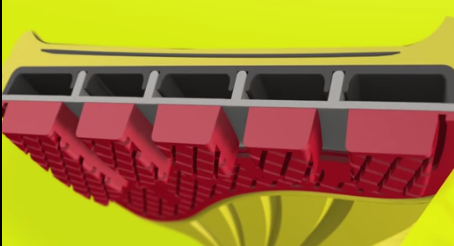

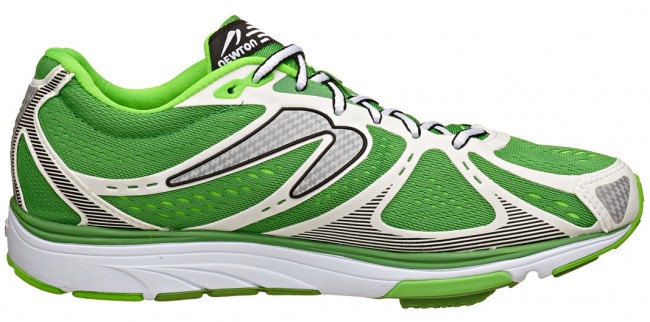
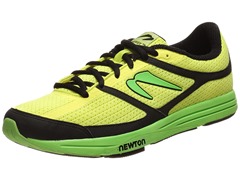
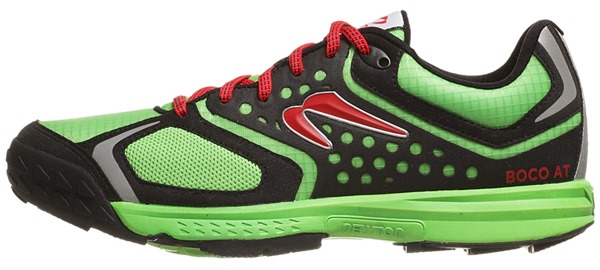
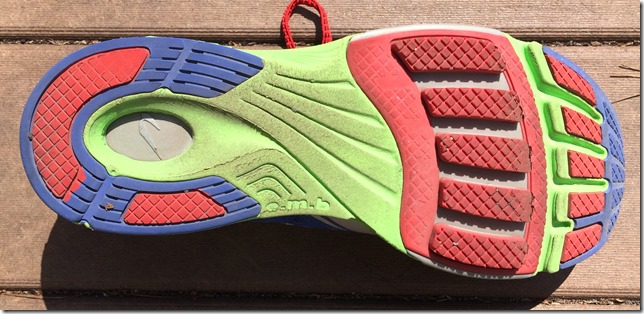

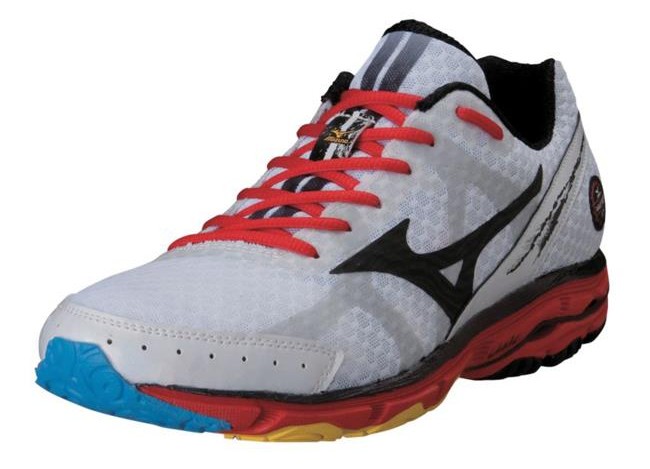














Thanks for the review! Just wondering what was the exact size you tested? My shoe fit seems to be almost the same as yours
Size 10 in the Kismet.
Hi Pete – I love Newtons and have run in a few. I would be interested in hearing how you think the Newton models differ from one another (energy, fate, distance, gravity, kismet, etc)
I actually don’t find a huge difference between most of the shoes. Kismet feels almost idential to the Motion, my guess is the Gravity would feel pretty similar to the Fate. Haven’t tried the new Energy/Aha or Distance III yet. Have a pair of the latter, need to take them for a run.
Pete,
Great review. The picture of the outsole shows a bit of wear at the top of the lugs, how many miles are on the shoes? Do you think durability will be a concern?
Probably about 50 miles. I think it’s mostly just abrasion of the nubs of the front of the lugs, typical for me in all Newtons. Might even make for a smoother transition if they wear down on the front. Not concerned about it myself.
I’m about 100 miles in to my pair of the Fate and this review nailed it. I really like them – my last pair of Newtons was the Distance III, and the move to the Fate has been perfect – I assume the Kismet would be no different in moving from the “S” version of the Distance III. I would say I had some issue with the sizing – in 4 lug Newtons, I was in their 10.5 and in 5 lug Newtons my size has dropped to 10. Newton customer service confirmed the “issue” and I have had no problems since making the switch.
What was your experience like with Distance III?
Haven’t run in it yet.
Ok, I thought it as me…but I developed blisters on my large toe and under my foot while running a 20 miler and then the actual Marathon because the toe box is just too big. Otherwise, I LOVE THIS SHOE!!!!!!
Can you comment on how it compares to the original Energy. I am considering buying those on closeout-none are available to try on near me, but I tried them at an expo last year and they felt a bit similar to Kinvara. Thanks!
Not as soft as the original Energy, better fit in the heel, more room in the toebox.
Hi Pete –
I have been running in Newtons since 2010 and love them! With the 4 lug system of the Distance U I’d always wear out the lateral lug so I thought the 5 lug system would be great for me. I bought the Distance III in early Aug and have slowly weaned them into my “rotation” – sadly it just isn’t working for me. Somehow my stride/foot placement has changed such that extra pressure is placed on the outside of my foot – the resulting pain became so bad I had to switch back to the 4 lug shoes. I’m now in a quandary as to whether to try a different shoe in the Newton line (Kismet vs. IM Elite 4 lug) or switch brands altogether (Saucony Kinvara 5?). First world problems indeed.
Help!
You might try the Aha or Energy 2 as the lugs are supposed to be more forgiving. Haven’t tried either myself so can’t comment from experience. I am a big fan of the Kinvara 5!
Thanks Pete!
Is it necessary to start with one of the “beginner” Newtons (Aha, Energy) before something like the Kismet? I am trying to transition to lower drop shoes and am intrigued by the Newtons.
No, I don’t think so. Just give a little time to adapt to the lugs as they can stress your forefoot a bit differently than other shoes.
Hi Pete! That is the best piece of advise that you can give to anyone new to the Newton running shoes: go slow with the lugs, specially those more protuberant. Last year I was so on to Newton running shoes, that all my four pairs on rotation were Newtons. Well, after putting roughly 1000 Km on them, I developed a Morton’s neuroma in my right foot and shin splints in my left leg. Needless to say that my love affair with Newton shoes ended right there.
Thanks for the review – I am also at a loss as to why 4.5 is on the side of the shoe, but the Runningwarehouse.com site states 7-8 Heel to Toe drop…. Anyway, Newton has produced yet another AWESOME product!!! I have 2 pairs of Motions and just bought the Kismet to Run the Chicago Marathon in. Even with Plantar Fasciitis – the shoes worked out extremely well!!!! Can’t wail to run in them completely healed :-)
Correction – I RAN the 2013 Chicago Marathon in the Kismets!
Can the Newton Kismet be used for exercise walking? I use custom orthotics. I wear a size 11 in New balance shoes and a size 11 1/2 in Saucony shoes. Thanks.
I personally would not choose a Newton shoe for walking, lugs feel weird when you roll over them.
when I emailed the Newton customer service, they told me the Kismet would be a very good shoe for exercise walking. Should I believe them?
Best bet would be to go to a specialty run store and try a pair on and see what you think. I personally would not choose a Newton shoe for walking due to the lugs under the forefoot.
Nice shoes it would be much better feeling to have them while cricketing.
Hi Pete,
I read your blog about the energy return of Adidas’ Boost technology….and the 1% claim. Without going into numbers, do you think Newton’s Action/Reaction has solid validity? Being that it’s all forefoot…as apposed to Boost mostly being a hell striker’s shoe.
There was a study that showed a 1% improvement for shoes with forefoot lugs, but with some individual variation. Read more here: link to runresearchjunkie.com
Hi Pete,
I’m currently looking for a new shoe (finding it very hard). I’m interested in the Newton Distance III, but I’m reading that the lugs are wearing out after 60 miles.
Surely that can’t be right on such an expensive shoe. I mean that’s only just over one week.
Could you put me right on this.
Thanks for all the great reviews
Wear will be highly individual. I do get wear on the front of Newton lugs in most of their shoes, but not so much that it impacts performance. Have not run in the Distance III though so can’t comment specifically on that one.
I like the refreshing honesty of your review, nice one. As an over pronator, are the Kismets my best option? to replace an older pair of IsaacS previously.
Also, are there any Newtons that you can seriously run a tame trail in?
The Kismet is a mild stability shoe, so if that is what you are looking for it is a good choice. As for trails, pretty much any shoe should work on a tame trail. Newton does make a shoe called the BoCo Sol that has a bit of tread for grip, bug may be unnecessary for the type of trail you describe.
I’ve had my kismets for 3 months and love them but now I’m running longer distances in them as my marathon approaches, I am developing really bad blisters on the sole of my right foot just above the arch on the ball and I don’t understand why. The left foot doesn’t have this problem and there doesn’t seem to be any faults with the right shoe. I’m wondering if the lugs are causing this. Has anyone else had this problem???
Hello Peter, Im supinator and I have two pairs of Newton kismet, the Orange and the green one! Do you think is OK for me ir orden to keep Running with them??
Peter,
Thank you for the great information you provided. I just bought my first pair of Newtons and I decided to get the Kismet model. I can’t wait to hit the road in them. I’m more of a 10K runner but my goal is to run a 1/2 Marathon. Looking forward to reach new goals in my newton shoes. Thanks again!